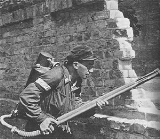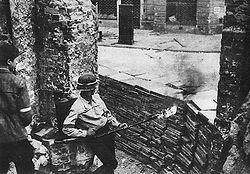
K pattern flamethrower
Encyclopedia
The K pattern was a man-portable backpack flamethrower
, produced in occupied Poland during World War II
for the underground Home Army. These flamethrowers were used in the Warsaw Uprising
in 1944.
The main parts of the flamethrower were two steel cylindrical tanks connected with each other, one for fuel (15 l capacity total, height 45 cm, diameter 16 cm) and a compressed air bottle (6 l, height 60 cm, diameter 12 cm). This tank assembly was fitted with straps to permit it to be carried on the operator's back. Fuel was a mixture of diesel fuel (75%) and gasoline
(25%). There was a valve between the fuel and air tanks. A rubber fuel hose connected the assembly with a fuel gun, which was a pipe 114-cm long, fitted with a valve at the muzzle, operated with a handle.
After opening a fuel gun valve, the fuel was propelled with compressed air and ignited by a simple mesh basket wrapped with a flaming rope, at the muzzle of the fuel gun (the rope had to be ignited before the weapon could be used). Normal way of operation were short 1-second bursts - about 30 could be fired. The mesh basket with the rope was extinguished with a tin can.
The K-pattern flamethrower appeared a successful weapon, considering its primitive design and conditions of manufacturing. Its main flaw was that the air pressure decreased during operation so that successive bursts had a progressively shorter range. The weapon could be refueled by fuel carriers and the compressed air bottle replaced with a new one, in a procedure that took about 4 minutes.

At the outbreak of Warsaw Uprising
the Polish forces had only 30 flamethrowers - many were lost in secret stores discovered by the Germans, and a number remained in stores that were not available for insurgents. Nonetheless, they were actively used in sectors of most fierce street fighting during the uprising. A number of flamethrowers were produced during the uprising. Most sections acted alone, but there was also one flamethrower company formed.
Flamethrower
A flamethrower is a mechanical device designed to project a long controllable stream of fire.Some flamethrowers project a stream of ignited flammable liquid; some project a long gas flame. Most military flamethrowers use liquids, but commercial flamethrowers tend to use high-pressure propane and...
, produced in occupied Poland during World War II
World War II
World War II, or the Second World War , was a global conflict lasting from 1939 to 1945, involving most of the world's nations—including all of the great powers—eventually forming two opposing military alliances: the Allies and the Axis...
for the underground Home Army. These flamethrowers were used in the Warsaw Uprising
Warsaw Uprising
The Warsaw Uprising was a major World War II operation by the Polish resistance Home Army , to liberate Warsaw from Nazi Germany. The rebellion was timed to coincide with the Soviet Union's Red Army approaching the eastern suburbs of the city and the retreat of German forces...
in 1944.
Construction
Design work upon a simple flamethrower for the Polish underground, suitable for production in ordinary workshops, of readily available materials, started in 1942 on request of the Home Army main headquarters. Its main purpose was to be used against armoured vehicles. There were several designs produced, of which the most popular was the K pattern, becoming a sort of standard weapon of the Polish underground. The exact number produced is difficult to estimate, but it was many hundreds (in one workshop of Antoni Więckowski in Warsaw alone, there were about 400 produced). Its production was concentrated in Warsaw. Due to production conditions, many flamethrowers differed in details.The main parts of the flamethrower were two steel cylindrical tanks connected with each other, one for fuel (15 l capacity total, height 45 cm, diameter 16 cm) and a compressed air bottle (6 l, height 60 cm, diameter 12 cm). This tank assembly was fitted with straps to permit it to be carried on the operator's back. Fuel was a mixture of diesel fuel (75%) and gasoline
Gasoline
Gasoline , or petrol , is a toxic, translucent, petroleum-derived liquid that is primarily used as a fuel in internal combustion engines. It consists mostly of organic compounds obtained by the fractional distillation of petroleum, enhanced with a variety of additives. Some gasolines also contain...
(25%). There was a valve between the fuel and air tanks. A rubber fuel hose connected the assembly with a fuel gun, which was a pipe 114-cm long, fitted with a valve at the muzzle, operated with a handle.
After opening a fuel gun valve, the fuel was propelled with compressed air and ignited by a simple mesh basket wrapped with a flaming rope, at the muzzle of the fuel gun (the rope had to be ignited before the weapon could be used). Normal way of operation were short 1-second bursts - about 30 could be fired. The mesh basket with the rope was extinguished with a tin can.
The K-pattern flamethrower appeared a successful weapon, considering its primitive design and conditions of manufacturing. Its main flaw was that the air pressure decreased during operation so that successive bursts had a progressively shorter range. The weapon could be refueled by fuel carriers and the compressed air bottle replaced with a new one, in a procedure that took about 4 minutes.

Combat usage
A flamethrower section consisted of 4 soldiers: a commander, a gunner carrying the flamethrower and two carriers of fuel cans and spare air bottles.At the outbreak of Warsaw Uprising
Warsaw Uprising
The Warsaw Uprising was a major World War II operation by the Polish resistance Home Army , to liberate Warsaw from Nazi Germany. The rebellion was timed to coincide with the Soviet Union's Red Army approaching the eastern suburbs of the city and the retreat of German forces...
the Polish forces had only 30 flamethrowers - many were lost in secret stores discovered by the Germans, and a number remained in stores that were not available for insurgents. Nonetheless, they were actively used in sectors of most fierce street fighting during the uprising. A number of flamethrowers were produced during the uprising. Most sections acted alone, but there was also one flamethrower company formed.
Sources
- Mariusz Skotnicki, Miotacz ognia wzór "K", in: Nowa Technika Wojskowa 7/98, p.59. ISSN 1230-1655

